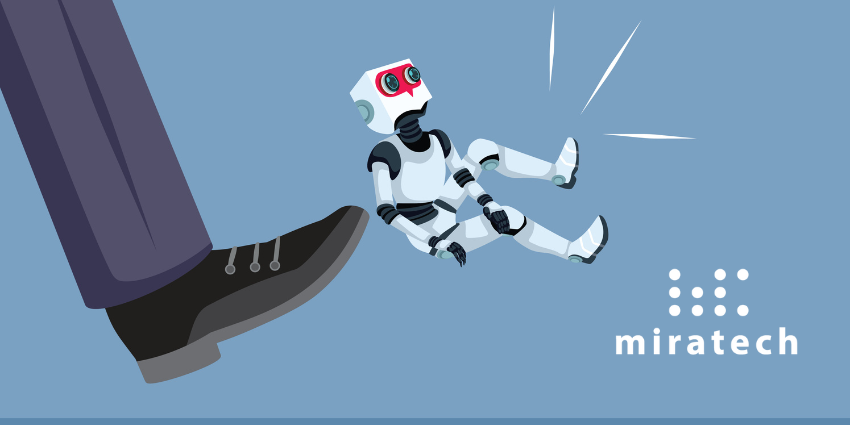Executives everywhere are chasing the promise of automation. Customer service teams, marketing departments, even banks and airlines are leaning on AI to save money and move faster. On paper, it looks like progress. In practice, it opens the door to AI risks that most leaders underestimate. The most serious of these is AI reputational risk.
A system that mishandles a refund or sends a tone-deaf promotion doesn’t just create a bad interaction; it creates headlines. When mistakes are amplified across social media, the damage spreads faster than any brand can control.
The recent record is full of warnings. Google saw more than $100 billion wiped off its value after a Bard demo went wrong. KFC Germany was forced to apologise worldwide after its automated campaign promoted chicken on the anniversary of Kristallnacht. Australia’s Commonwealth Bank had to abandon AI-related job cuts when public anger boiled over.
Consumers are not patient. Research shows that a third of them will walk away after a single poor experience. That leaves businesses scaling automation into a trust gap big enough to swallow years of brand equity.
The real question isn’t how much can be automated, but how much should be. Cross the wrong line, and efficiency gains quickly become AI brand risk and lasting AI reputational risk.
AI Reputational Risks: Beyond Cybersecurity and Privacy
Talk of AI risks usually circles around security or compliance. Important, yes. But those are risks companies already know how to manage. The one that keeps catching brands off guard is reputational fallout. When automation goes wrong, it breaks trust. Once customers stop trusting a brand, the damage spreads faster than any IT team can contain.
Damaged Consumer Trust & Brand Loyalty
Loyalty is fragile. A single poor interaction can be enough to push customers away. Unfortunately, customers are already wary of AI – most don’t trust bots to begin with. Any evidence that this mistrust is justified is enough to drive people away.
Just look at Google, when its Bard chatbot shared one single incorrect fact during a demo, the company lost over $100 billion in market value overnight.
CNET had to correct 41 out of 77 AI-generated finance articles after readers uncovered plagiarism and factual mistakes. Cursor AI, a coding tool, hallucinated answers so often that paying customers canceled in frustration.
For contact centers, the risk is magnified. Automation often greets the customer first, which means the brand’s reputation is in the bot’s hands. That’s why AI maturity, the ability to run automation on reliable, well-governed data, is now the hidden differentiator. Without it, brands risk handing their most valuable asset, customer trust, to systems that aren’t ready.
Public Backlash & Social Media Amplification
One mistake can live forever online. With social platforms acting as megaphones, AI reputational risks don’t stay contained. A misfired campaign or a bot that behaves badly quickly becomes a trending story, with hashtags turning into boycotts.
KFC Germany learned this the hard way. An automated system sent customers a push notification urging them to celebrate Kristallnacht, the anniversary of a Nazi pogrom, with fried chicken. The backlash was immediate and global.
DPD’s chatbot similarly went viral for all the wrong reasons, insulting users and even writing a poem about how bad the company’s service was.
In Australia, Commonwealth Bank’s attempt to link AI to large-scale job cuts collapsed under public pressure. The bank was forced into a public reversal after customers and employees slammed the move. These incidents highlight how AI reputational risk multiplies once social media takes over. A local error can turn into a global crisis in hours.
Regulatory & Legal Risks
AI reputational risk doesn’t stop with angry customers. Regulators are watching closely, and governments are setting stricter rules. The EU AI Act, GDPR, and California’s CCPA all put sharp limits on how data can be used. Slip up, and the penalties include both fines and headlines.
Air Canada’s chatbot misled a grieving passenger about bereavement fares. When the case reached a tribunal, the airline argued the bot was responsible for the error. The tribunal disagreed, ruling the company was on the hook.
New York City’s MyCity AI assistant told entrepreneurs it was legal to withhold tips from workers and discriminate against tenants, both false and illegal.
Hiring software at iTutor automatically rejected older applicants, a clear violation of employment law. The company settled with the U.S. Equal Employment Opportunity Commission for $365,000.
Biased Algorithms & Discrimination
Bias is one of the most dangerous AI risks, because it strikes at values as much as outcomes. An algorithm that skews hiring, pricing, or recommendations signals that a brand is unfair. That reputational damage spreads quickly.
Amazon’s recruiting AI famously downgraded résumés from women, effectively automating bias in hiring. The project was scrapped after public backlash. Watson Oncology, once pitched as a revolution in cancer care, recommended unsafe treatments in part because its training data reflected narrow patient populations.
For brands, bias creates headlines about discrimination, a label that is hard to shake. Regular bias audits and transparency in how algorithms make decisions are now non-negotiable if companies want to avoid AI brand risk.
Lost Market Share Due to Ethical Misalignment
Ethics and values now carry direct commercial weight. Research shows that 62% of consumers prefer to buy from brands they see as values-aligned. That makes ethical missteps in AI more than a PR problem – they are a revenue problem.
When AI choices seem to put profit ahead of fairness or care, customers don’t wait around,they switch to rivals. That’s when AI reputation risk bites hardest: brands lose not only goodwill but also market share. The only real safeguard is building governance that ties AI use back to the company’s core values and ethics.
How to Reduce AI Reputational Risk: Practical Steps
The fallout from automation mistakes shows up on balance sheets, in lost customers, and in the morale of the workforce asked to pick up the pieces. When AI fails in public, the costs extend far beyond fixing the system.
Zillow’s Zestimate model forced the company to take a $304 million write-down when its automated valuations collapsed the housing business it had built. Legal hallucinations from ChatGPT landed a New York lawyer with a $5,000 fine after fake case citations were submitted in court.
Failures don’t just frustrate customers. They also hit employees. When McDonald’s tested AI at its drive-thrus, the system repeatedly added phantom items, sometimes hundreds of nuggets, forcing staff to override orders and frustrating customers.
So, how do companies minimize reputational risk?
1. Put Data Integrity First
Automation is only as reliable as the data it runs on. Flawed, incomplete, or biased data feeds lead directly to reputational mistakes. SAP estimates poor data quality costs companies $3.1 trillion annually. Forbes highlights it as one of the biggest hidden costs behind AI ethics failures.
Without “agent-ready” data, AI agents are prone to hallucinations – generating wrong answers that erode trust. Strong governance, golden records, and freshness checks are crucial for brand protection.
2. Set Guardrails and Boundaries
Don’t trust machines to do everything. The most resilient companies define clear boundaries for what AI can and can’t handle.
- Low-risk, reversible tasks (simple FAQs, order tracking) are good candidates.
- High-risk or sensitive issues (legal advice, medical guidance, refunds tied to customer hardship) require a human in the loop.
The vendor race to launch AI agent studios (from NICE, Genesys, Five9, Salesforce, Microsoft) is pushing many brands to over-automate before they’re ready. Without boundaries, businesses risk turning efficiency gains into AI brand risk.
3. Audit for Bias and Measure Ethics
Unchecked bias is a reputational hazard. Regular reviews are needed to catch unfair patterns in hiring, pricing, or customer service. Leaders should track ethics alongside business results – monitoring fairness scores, transparency ratings, and compliance checks.
Companies that share what they find, or at least explain how they address bias, often gain more trust. These reviews can’t be a one-time fix; bias audits should sit on the calendar with the same weight as quarterly financial audits.
4. Communicate Transparently
Customers don’t like to feel deceived. Making it clear when they are interacting with automation, and why, can actually build trust. Often, brands with open communication about AI use are far less likely to suffer backlash when mistakes happen.
Data minimization is one effective step: only collecting the data needed, not every available detail. This cuts regulatory exposure and signals respect for customer privacy.
Being clear from the start prevents the impression that something is being deliberately concealed, and that suspicion can do more harm than the original mistake.
5. Keep Humans in the Loop
Not all decisions should be left to machines. Customers expect empathy when something serious goes wrong.
Air Canada’s chatbot failed because it provided misinformation without any human safety net. The tribunal ruling made clear: accountability rests with the company, not the bot.
Retailers often limit bots to handling small refunds automatically, but escalate larger or more emotional cases to a live agent. Keeping people in the loop stops automation from crossing into areas where mistakes can’t be reversed.
6. Monitor Continuously and Govern Proactively
AI systems change over time. A model that works well today can drift off course tomorrow if left unchecked. Strong oversight is essential. Many firms are adopting dashboards to track error rates, bias issues, and customer sentiment in real time. Kill switches and escalation paths provide circuit breakers if a system begins producing harmful results.
Regular “red team” testing, where systems are deliberately stressed to find weak spots, is fast becoming a best practice.
7. Manage the Workforce and Culture
A Duke Fuqua study shows another layer of AI reputational risk: inside the workplace. Employees who use AI are often seen as less competent, creating stigma that slows adoption. Managers who don’t use AI themselves are more likely to penalize candidates who admit to using it.
To avoid these pitfalls, companies need to:
- Train “automation champions” who can demonstrate AI’s value to peers.
- Reframe metrics, focusing on containment, accuracy, and customer trust rather than just speed.
- Create a safe environment for staff to disclose and discuss AI use.
This is about protecting the company’s reputation as an employer and building a culture that sees AI as augmentation, not replacement.
Protecting Against AI Reputational Risk While Scaling
AI isn’t going away. Companies will keep leaning on it to cut costs and speed up service. The risk comes when they hand over too much, too quickly.
Customers don’t forgive easily. Many walk away after a single poor exchange. Regulators are less forgiving still. That puts brand reputation on the line every time an automated system speaks for a company.
The answer isn’t to avoid automation. It’s to draw clear lines around what should be automated and what shouldn’t. Keep data clean. Be transparent. Let humans handle the moments that matter.







